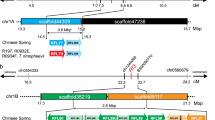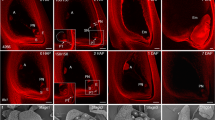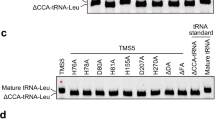Abstract
Temperature-sensitive genic male sterility (TGMS) lines are widely used in the breeding of hybrid crops1,2, but by what means temperature as a general environmental factor reverses the fertility of different TGMS lines remains unknown. Here, we identified an Arabidopsis TGMS line named reversible male sterile (rvms) that is fertile at low temperature (17 °C) and encodes a GDSL lipase. Cytological observations and statistical analysis showed that low temperature slows pollen development. Further screening of restorers of rvms, as well as crossing with a slow-growth line at normal temperature (24 °C), demonstrate that slowing of development overcomes the defects of rvms microspores and allows them to develop into functional pollen. Several other Arabidopsis TGMS lines were identified, and their fertility was also restored by slowing of development. Given that male reproductive development is conserved3, we propose that slowing of development is a general mechanism applicable to the sterility–fertility conversion of TGMS lines from different plant species.
This is a preview of subscription content, access via your institution
Access options
Access Nature and 54 other Nature Portfolio journals
Get Nature+, our best-value online-access subscription
$29.99 / 30 days
cancel any time
Subscribe to this journal
Receive 12 digital issues and online access to articles
$119.00 per year
only $9.92 per issue
Buy this article
- Purchase on SpringerLink
- Instant access to full article PDF
Prices may be subject to local taxes which are calculated during checkout




Similar content being viewed by others
Data availability
The data that support the findings of this study are available from the corresponding author upon request.
References
Chen, L. & Liu, Y. G. Male sterility and fertility restoration in crops. Annu. Rev. Plant Biol. 65, 579–606 (2014).
Virmani, S. S. & Ilyas-Ahmed, M. Environment-sensitive genic male sterility (EGMS) in crops. Adv. Agron. 72, 139–195 (2001).
Gómez, J. F., Talle, B. & Wilson, Z. A. Anther and pollen development: a conserved developmental pathway. J. Integr. Plant Biol. 57, 876–891 (2015).
Hochholdinger, F. & Hoecker, N. Towards the molecular basis of heterosis. Trends Plant Sci. 12, 427–432 (2007).
Tester, M. & Langridge, P. Breeding technologies to increase crop production in a changing world. Science 327, 818–822 (2010).
Zhang, Q. et al. Using bulked extremes and recessive class to map genes for photoperiod-sensitive genic male sterility in rice. Proc. Natl Acad. Sci. USA 91, 8675–8679 (1994).
Wang, H. et al. The Arabidopsis U-box/ARM repeat E3 ligase AtPUB4 influences growth and degeneration of tapetal cells, and its mutation leads to conditional male sterility. Plant J. 74, 511–523 (2013).
Millar, A. A. & Gubler, F. The Arabidopsis GAMYB-like genes, MYB33 and MYB65, are microRNA-regulated genes that redundantly facilitate anther development. Plant Cell 17, 705–721 (2005).
Zhou, H. et al. Photoperiod- and thermo-sensitive genic male sterility in rice are caused by a point mutation in a novel noncoding RNA that produces a small RNA. Cell Res. 22, 649–660 (2012).
Ding, J. et al. A long noncoding RNA regulates photoperiod-sensitive male sterility, an essential component of hybrid rice. Proc. Natl Acad. Sci. USA 109, 2654–2659 (2012).
Fan, Y. et al. PMS1T, producing phased small-interfering RNAs, regulates photoperiod-sensitive male sterility in rice. Proc. Natl Acad. Sci. USA 113, 15144–15149 (2016).
Zhou, H. et al. RNase ZS1 processes Ub L40 mRNAs and controls thermosensitive genic male sterility in rice. Nat. Commun. 5, 4884 (2014).
Chen, R. Z. et al. Rice UDP-glucose pyrophosphorylase1 is essential for pollen callose deposition and its cosuppression results in a new type of thermosensitive genic male sterility. Plant Cell 19, 847–861 (2007).
Yu, J. et al. Two rice receptor-like kinases maintain male fertility under changing temperatures. Proc. Natl Acad. Sci. USA 114, 12327–12332 (2017).
Shi, J., Cui, M., Yang, L., Kim, Y. J. & Zhang, D. Genetic and biochemical mechanisms of pollen wall development. Trends Plant Sci. 20, 741–753 (2015).
Akoh, C. C., Lee, G. C., Liaw, Y. C., Huang, T. H. & Shaw, J. F. GDSL family of serine esterases/lipases. Prog. Lipid Res. 43, 534–552 (2004).
Ma, H. Molecular genetic analyses of microsporogenesis and microgametogenesis in flowering plants. Annu. Rev. Plant Biol. 56, 393–434 (2005).
Iwakawa, H., Shinmyo, A. & Sekine, M. Arabidopsis CDKA;1, a cdc2 homologue, controls proliferation of generative cells in male gametogenesis. Plant J. 45, 819–831 (2006).
Wijnker, E. et al. The Cdk1/Cdk2 homolog CDKA;1 controls the recombination landscape in Arabidopsis. Proc. Natl Acad. Sci. USA 116, 12534–12539 (2019).
Magnard, J. L., Yang, M., Chen, Y. C., Leary, M. & McCormick, S. The Arabidopsis gene tardy asynchronous meiosis is required for the normal pace and synchrony of cell division during male meiosis. Plant Physiol. 127, 1157–1166 (2001).
Wang, Y., Magnard, J. L., McCormick, S. & Yang, M. Progression through meiosis I and meiosis II in Arabidopsis anthers is regulated by an A-type cyclin predominately expressed in prophase I. Plant Physiol. 136, 4127–4135 (2004).
Cromer, L. et al. OSD1 promotes meiotic progression via APC/C inhibition and forms a regulatory network with TDM and CYCA1;2/TAM. PLoS Genet. 8, e1002865 (2012).
Verkest, A. et al. The cyclin-dependent kinase inhibitor KRP2 controls the onset of the endoreduplication cycle during Arabidopsis leaf development through inhibition of mitotic CDKA;1 kinase complexes. Plant Cell 17, 1723–1736 (2005).
Cao, Z. L. et al. Mapping and analysis of a yellow mutant chlm-4 of Arabidopsis thaliana. Acta Bot. Yunnan. 32, 134–140 (2010).
Dong, X., Hong, Z., Sivaramakrishnan, M., Mahfouz, M. & Verma, D. P. Callose synthase (CalS5) is required for exine formation during microgametogenesis and for pollen viability in Arabidopsis. Plant J. 42, 315–328 (2005).
Guan, Y. F. et al. RUPTURED POLLEN GRAIN1, a member of the MtN3/saliva gene family, is crucial for exine pattern formation and cell integrity of microspores in Arabidopsis. Plant Physiol. 147, 852–863 (2008).
de Azevedo, S. C. et al. A novel fatty Acyl-CoA synthetase is required for pollen development and sporopollenin biosynthesis in Arabidopsis. Plant Cell 21, 507–525 (2009).
Morant, M. et al. CYP703 is an ancient cytochrome P450 in land plants catalyzing in-chain hydroxylation of lauric acid to provide building blocks for sporopollenin synthesis in pollen. Plant Cell 19, 1473–1487 (2007).
Quilichini, T. D., Friedmann, M. C., Samuels, A. L. & Douglas, C. J. ATP-binding cassette transporter G26 is required for male fertility and pollen exine formation in Arabidopsis. Plant Physiol. 154, 678–690 (2010).
Cassidy, J. J. et al. Repressive gene regulation synchronizes development with cellular metabolism. Cell 178, 980–992 (2019).
Yi, J. et al. Genetic and mapping analysis of Arabidopsis thaliana male sterile mutant m1502. Acta Bot. Yunnan. 28, 283–288 (2006).
Zhang, Z. B. et al. Transcription factor AtMYB103 is required for anther development by regulating tapetum development, callose dissolution and exine formation in Arabidopsis. Plant J. 52, 528–538 (2007).
Lou, Y. et al. The tapetal AHL family protein TEK determines nexine formation in the pollen wall. Nat. Commun. 5, 3855 (2014).
Lou, Y. et al. Positive regulation of AMS by TDF1 and the formation of a TDF1-AMS complex are required for anther development in Arabidopsis thaliana. New Phytol. 217, 378–391 (2018).
Huang, X. Y. et al. CYCLIN-DEPENDENT KINASE G1 is associated with the spliceosome to regulate CALLOSE SYNTHASE5 splicing and pollen wall formation in Arabidopsis. Plant Cell 25, 637–648 (2013).
Wang, S. et al. Dissecting a heterotic gene through GradedPool-Seq mapping informs a rice-improvement strategy. Nat. Commun. 10, 2982 (2019).
Acknowledgements
We thank H. Huang, L. Xu, J.-D. Rochaix, S. McCormick, J. Xu, L.-W. Peng and L. Zhang for discussions about this manuscript. This work was supported by grants from the National Key Research and Development Program of China (no. 2016YFD0100902), National Science Foundation of China (nos. 31770348 and 31600243), Science and Technology Commission of Shanghai Municipality (nos. 18DZ2260500 and 17DZ2252700) and the Innovation Program of Shanghai Municipal Education Commission (no. 2019-01-07-00-02-E00006).
Author information
Authors and Affiliations
Contributions
The project leader is Z.-N.Y. Z.-N.Y. and J.Z. conceived the experiments. J.Z. and Y.L. performed thermo-sensitive phenotype analysis. Q.-S.S. and J.Z. performed statistical analysis of microspore development. Q.-S.S. contributed to analysis of restorers of rvms-2. S.Z. contributed fine mapping of RVMS. W.-T.Z. contributed enzyme activity assays. J.Y. and Y.L. performed genetic complementation. J.-Q.H. and J.-Q.W. detected the expression of RES1. C.Z., T.X., J.-L.L. and L.Z. analysed fertility restoration of pollen-wall-related mutants. X.-H.H contributed BAS-seq analysis. J.Z. and Y.L. wrote the paper with input from Z.-N.Y. S.W. and X.-Z.Y. revised the manuscript. All authors discussed the results and commented on the manuscript.
Corresponding author
Ethics declarations
Competing interests
The authors declare no competing interests.
Additional information
Peer review information Nature Plants thanks Danny Geelen, Yidan Ouyang, Dabing Zhang and the other, anonymous, reviewer(s) for their contribution to the peer review of this work.
Publisher’s note Springer Nature remains neutral with regard to jurisdictional claims in published maps and institutional affiliations.
Supplementary information
Supplementary Information
Supplementary Figs. 1–26 and Tables 1–3.
Rights and permissions
About this article
Cite this article
Zhu, J., Lou, Y., Shi, QS. et al. Slowing development restores the fertility of thermo-sensitive male-sterile plant lines. Nat. Plants 6, 360–367 (2020). https://doi.org/10.1038/s41477-020-0622-6
Received:
Accepted:
Published:
Issue Date:
DOI: https://doi.org/10.1038/s41477-020-0622-6
This article is cited by
-
Consistency in patterns of pollen sterility between floral morphs in distylous populations of Erythroxylum (Erythroxylaceae)
Plant Systematics and Evolution (2025)
-
Polymeric phenylpropanoid derivatives crosslinked by hydroxyl fatty acids form the core structure of rape sporopollenin
Nature Plants (2024)
-
Impaired 2′,3′-cyclic phosphate tRNA repair causes thermo-sensitive genic male sterility in rice
Cell Research (2024)
-
OsSRF8 interacts with OsINP1 and OsDAF1 to regulate pollen aperture formation in rice
Nature Communications (2024)
-
An Improved Chromosome-Level Genome Assembly and Annotation of Belted Beard Grunt (Hapalogenys analis)
Journal of Ocean University of China (2024)



